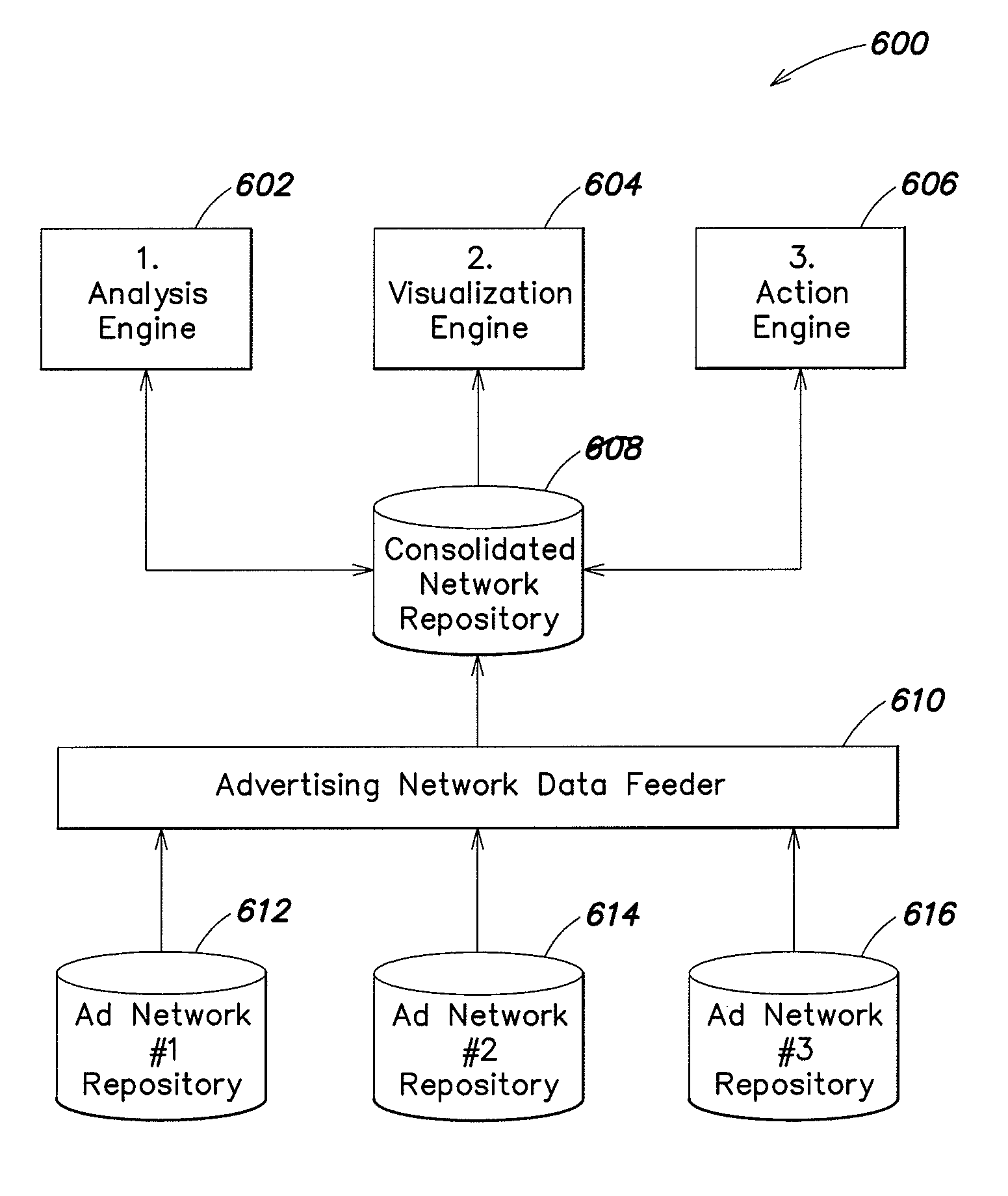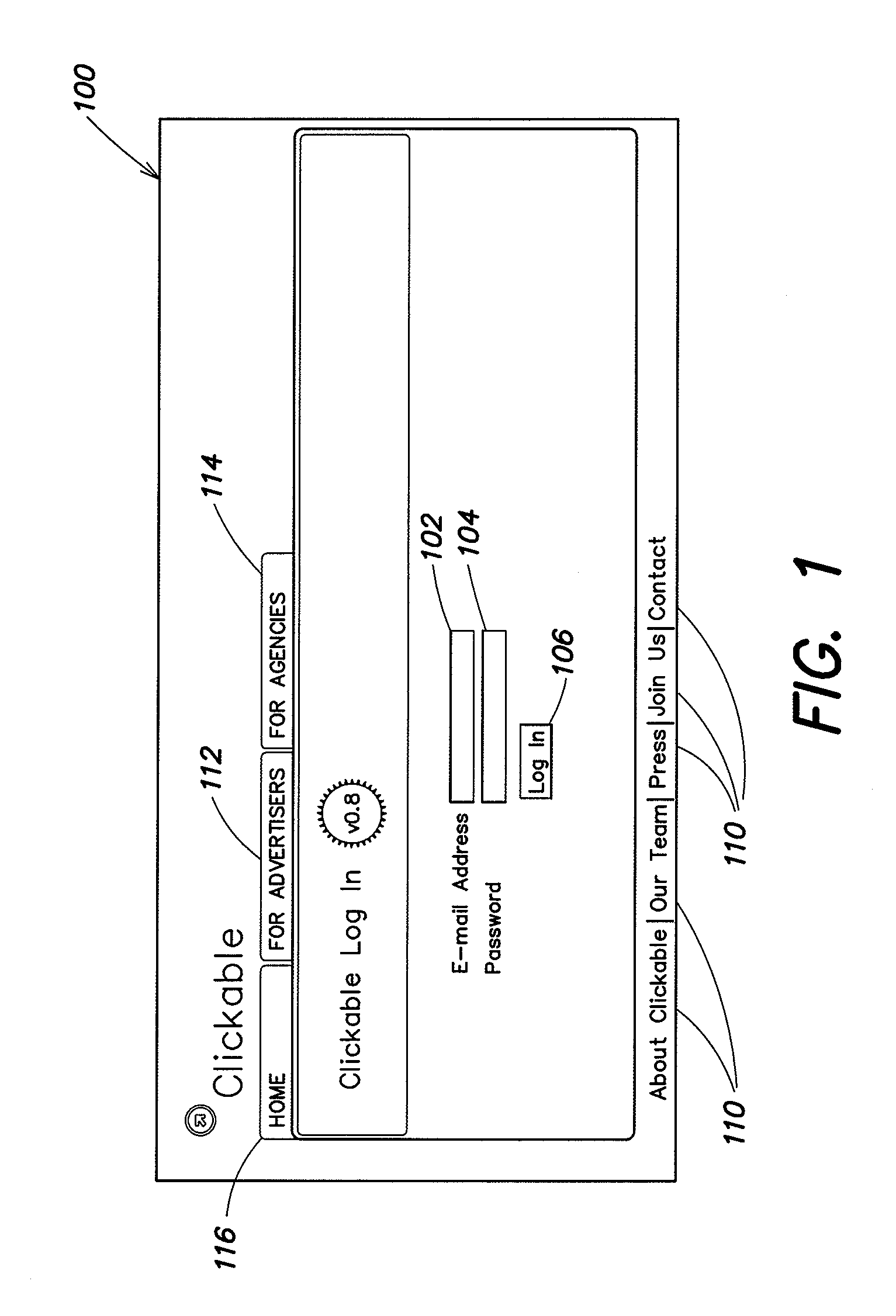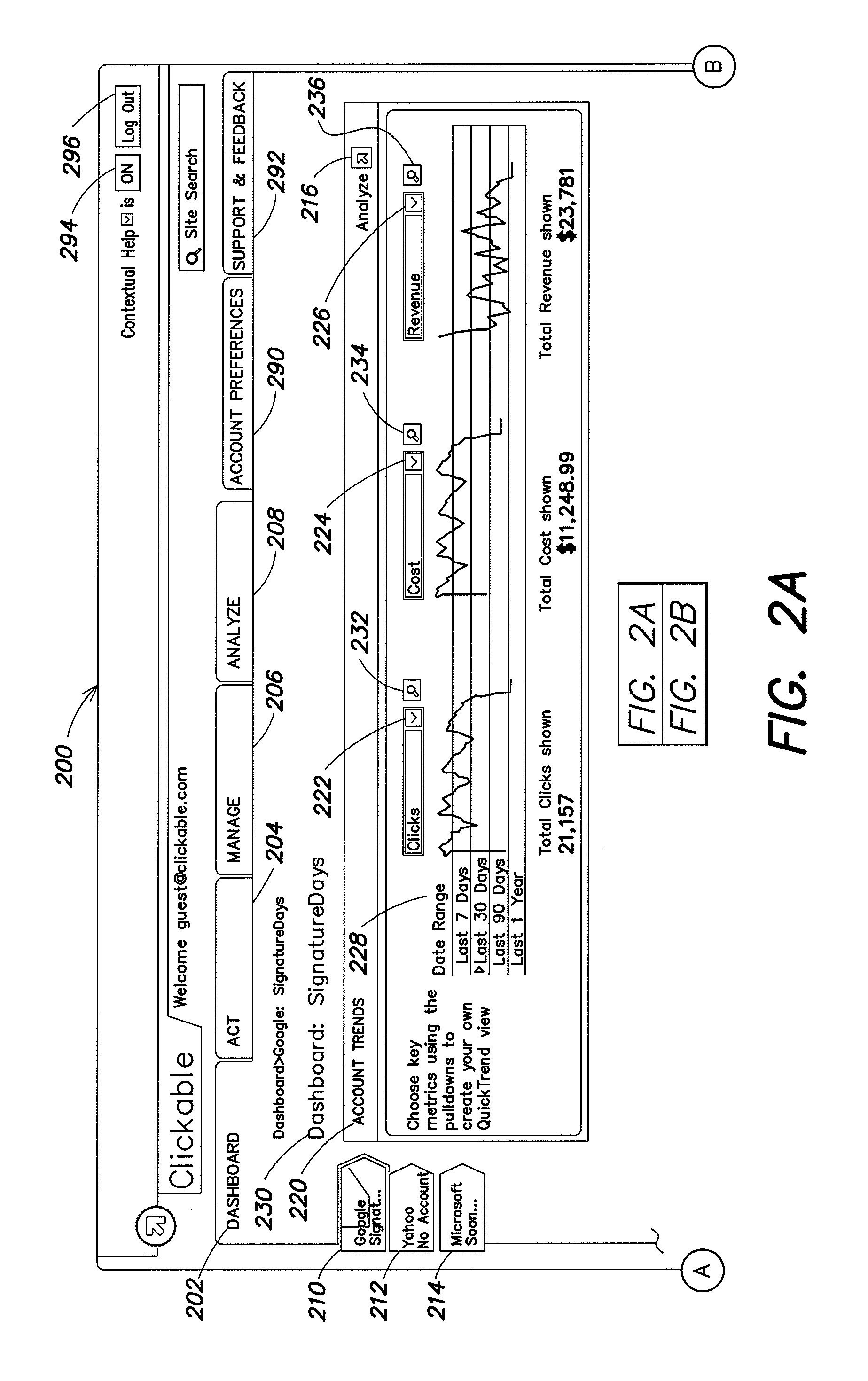[0006]By implementing the method or systems for managing a plurality of advertising networks, various embodiments of the present invention may overcome some of the shortcomings of conventional advertising management systems. According to one embodiment, the ability to manage various advertisement networks down to the minute details that make up each individual advertisement is made significantly easier through improved visualization of advertisement
metrics, as well as by automated tracking of the advertising
metrics, and by developing automated recommendations based on analysis of the advertising metrics.
[0008]According to one aspect, advertisements and the information associated with them are organized into a hierarchy to facilitate their display. Advertisements can grouped together at a number of levels in order to represent them and the information related to them visually. In one example, ads are organized by the keywords that are used, as well as by the ad copy that appears in the ad. In another example, at a higher level, keyword, ad copy and ads are organized into an ad groups, where multiple ad groups may refer to one ad. In one embodiment, Ad groups are further organized into ad campaigns, and all the ad campaigns hosted or generated at a particular source are grouped into an advertising network. In another embodiment, the various ad networks being managed are organized into a management account. For example, a manager may have ads with Google adwords (an ad network), where the ads are organized into the ad campaign Boston-Local, which has cooking, dinner,
fishing, and paintball associated with it (ad groups). In the example, the ad group dinner contains keywords “boston dinner
cruise”“boston dinner cruises” among others. The ad group dinner also contains the ads and ad copy associated with the ad group dinner. According to one embodiment, hierarchical organization facilitates the display of the elements associated with any ad as well as any information / metrics associated with those elements.
[0009]According to another aspect, the analysis portion of the advertising
management system may be configured to automatically perform actions on the various ads being managed without user intervention. In one embodiment, such actions are related to management accounts, ad networks, advertising campaigns, ad groups, and keywords. One should appreciate that actions can occur at any level of the organization related to an ad or ads. The result is a
fine tuning of advertisement vehicles without consuming user time. Even where automated
processing is not used, the user's time is optimized by streamlining the presentation of the advertising metrics visually. Additionally, the
management system can be configured to prompt the user with recommended actions, for example, when the user runs a mouse pointer over a particular metric or visual display of aggregated information, a window may be displayed with a recommended action. In one embodiment, the user selects an option, for example, by pressing a button, to display recommended actions. In another embodiment, the management
system displays additional information that will enable the user to make better decisions regarding an advertising campaign. In one example, a user is attempting to improve advertising copy (“ad copy”) to increase clickthrus for a particular advertising campaign. In the example, the management
system displays an option to the user to see ad copy of other advertisers that are performing better or that are in a related advertising space. Typically, the system displays an option to the user to see the ad copy from the best five campaigns with similar targets, geography, and keywords, as examples. One should appreciate the displayed recommendations can be configured to base similarity or recommendations on almost any feature associated with an ad. According to one embodiment, the advertisement management system is configured to notify users / managers when particularly sensitive events occur, and / or where an
impact level / threshold is exceeded, in addition to the visual displays of information. Such notification may take place by, for example, e-mail,
text message, page, or other messaging formats.
[0011]According to another aspect of an embodiment of the present invention, an integrated management interface is provided to track advertisement metrics across a plurality of advertising networks, aggregate the information, and render the aggregated information in an easily understood, and easily acted upon format. According to one embodiment, each of the plurality of advertising networks will be organized into a management account and typically include multiple advertising campaigns, where each ad campaign represents an organization of ads and information associated with ads by any one of location,
by product, by categories, among other options. Each advertising campaign will include information relating to at least one particular ad group, for example Boston—Local (this particular ad group represents an organization of ads (and / or information related to those ads) targeting Boston consumers with locally styled advertising). Each campaign may include multiple ad groups and a variety of geographical targets for each. Ad campaigns (campaigns) may be national, international, local, regional, among others. This variety represents one issue in managing and presenting information in order to enable intelligent decisions and enable a user / manager the ability to review the information at any level of desired detail. According to one embodiment, the aggregation, organization, and presentation of information related to managed ads aids in managing the respective ads.
[0021]According to one aspect of the present invention, a computer implemented method for improving
online advertising conversions is provided. The method comprises analyzing the raw advertising metrics to identify improvements to conversion in
online advertising, visualizing a tree in two-dimensional space in a treemap based visualization, and providing a rapid one-box recommendation that allows a user to take an action to improve its advertising campaign. According to one embodiment, the method further comprises an act of providing context associated with the action to improve the advertising campaign. According to another embodiment, analyzing the raw advertising metrics further comprises determining if the raw advertising metrics meet a predefined threshold. According to a further embodiment, the method further comprises an act of estimating an impact on the advertising campaign, based on the recommendation. According to one embodiment, the estimated impact is based, at least in part on, at least one of, a return on investment, click thru rate, conversions, conversion rate, impressions, unique visits,
quality score of a
landing page, a value of goods, visits to a desired product page, and average advertising position.
[0022]According to one aspect of the present invention, a computer-readable medium having computer-readable signals stored thereon that define instructions that, as a result of being executed by a computer, instruct the computer to perform a method for improving online advertising conversions is provided. The method comprises analyzing the raw advertising metrics to identify improvements to conversion in online advertising, visualizing a tree in two-dimensional space in a treemap based visualization, and providing a rapid one-box recommendation that allows a user to take an action to improve its advertising campaign. According to one embodiment, the method further comprises an act of providing context associated with the action to improve the advertising campaign. According to another embodiment, analyzing the raw advertising metrics further comprises determining if the raw advertising metrics meet a predefined threshold. According to a further embodiment, the method further comprises an act of estimating an impact on the advertising campaign, based on the recommendation. According to one embodiment, the estimated impact is based, at least in part on, at least one of, a return on investment, click thru rate, conversions, conversion rate, impressions, unique visits,
quality score of a
landing page, a value of goods, visits to a desired product page, and average advertising position.
 Login to View More
Login to View More  Login to View More
Login to View More 


